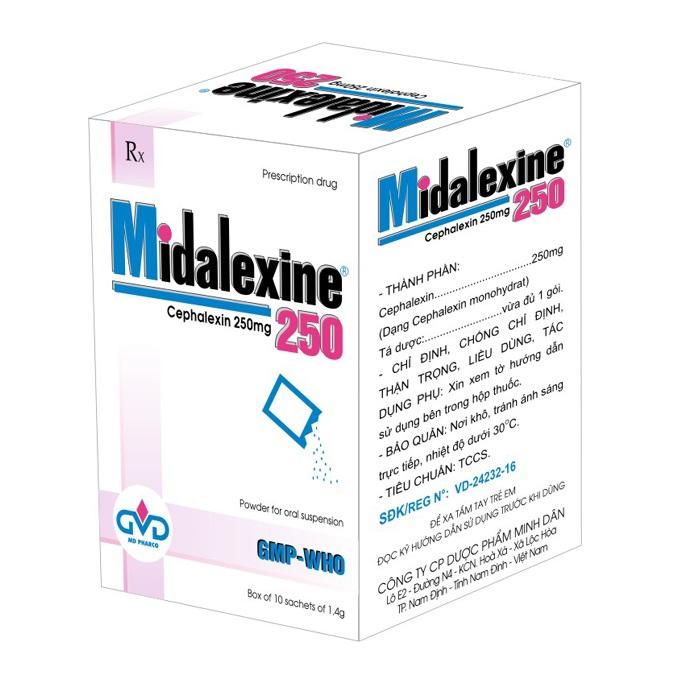Ingredient:
Cephalexin (as Cephalexin monohydrate) 250 mg
Function :
Cephalexin has an average active effect on gram-positive organisms such as staphylococcus, streptococcus, pneumococcal (other than methicillin-resistant streptococcus).
Cephalexin also works on some Gram-negative bacteria, including E.coli, Klebsiella pneumoniae, Proteus mirabilis and Shigella.
There are resistant strains: Enterococcus, Methicillin-resistant Staphylococcus, Proteus with indole-positive reaction, Enterobacter, Pseudomonas aeruginosa, Bacteroid.
Point :
- Respiratory tract infections: acute and chronic bronchitis and superfluous bronchiectasis.
Nasopharynx infections: otitis media, mastoiditis, sinusitis, tonsillitis and pharyngitis.
Urinary tract infections: acute and chronic pyelonephritis, cystitis, and prostatitis. Prevention of recurrent urinary tract infections.
- Infections and gynecological.
- Skin, soft tissue and bone infections.
- Gonorrhea and syphilis (when penicillin is not appropriate)
In dentistry: Temporary replacement of penicillin-preventative treatment for patients with heart disease who must treat dental disease.
Contraindications:
Susceptible to cephalosporin.
Caution:
Cefalexine is generally well tolerated in patients with penicillin allergy, but there are also very few cross-reactivity. Like antibiotics that are excreted primarily by the kidneys, when renal function is impaired, the dosage of cefalexine should be reduced to a suitable dose (see Dosage).
In patients taking Cefalexine, a false positive reaction may be seen in a glucoseuria test with Benedict's solution or Fehling's solution or a false positive with "Clinitest" tablets but this has no effect on the assessment. based on enzyme.
Cefalexine can affect the creatinine test with alkaline picrate, resulting in a high false-positive result, but elevated levels are almost unimportant in clinical settings.
During pregnancy:
Laboratory studies and clinical experience do not reveal evidence of teratogenic effects, but should be used with caution in the early months of pregnancy as with all other drugs.
Drug interactions :
Avoid using cephalexin for patients allergic to cephalosporin antibiotics. Because cephalexin has a chemical relationship with penicillin, sometimes a patient has an allergic (even anaphylactic) reaction to both drugs. Treating cephalexin as well as other antibiotics can alter the normal bowel culture in the colon, allowing overdose of C. difficile, a bacterium that causes pseudomembranous colitis. Patients with pseudomembranous colitis as a result of antibiotic treatment may have diarrhea, abdominal pain, fever, even shock. Cephalexin is not a habit. The safety of use in children has not been established.
Side effects
A small number of patients taking cefalexine may experience gastrointestinal disturbances such as nausea, vomiting and diarrhea. As with other widespread antibiotics, Cefalexine can cause the growth of symbiotic bacteria (Candida albicans can sometimes occur in the form of vaginitis).
A very small number of patients have recurrent neutropenia.
It is rare to have a rash, urticaria and lump.
Dosage - Usage:
The majority of infections in adults respond to doses of 1-2 g / day divided into multiple doses. For most infections, the simple dose regimen as follows may be adequate:
Adults and children over 12 years: 500mg x 3 times daily.
Children 5-12 years: 250mg x 3 times daily.
Children 1-5 years old: 125mg x 3 times daily.
Under 1 year: 125mg x 2 times daily.
In order to fit the situation, especially for patients traveling regularly, daily intake can be divided into 2 equal doses, ie 1g x 2 times daily for adults with urinary tract infections.
Consider the following information:
Adults:
Severe or localized infection, especially in cases of less sensitive bacteria: The dose should be increased to 1g x 3 times daily, or 1.5g x 4 times daily.
Prevention of recurrent UTIs: The recommended dose is 125mg per night and can be continued for several months.
Children: The dose should be calculated based on body weight, especially in young children. The following dosage recommendations for children are based on a normal dose of 25-60mg / kg / day. For chronic infections, serious or deep-seated infections, this dose should be increased to 100 mg / kg / day (maximum 4 days).
Children younger than 3 months: 62.5-125 mg twice daily.
Children 4 months to 2 years: 62.5-125mg x 4 times daily or 125-500mg x 2 times daily.
Children 3-6 years: 125-250mg x 4 times daily or 250-500mg x 2 times daily.
Children 7-12 years: 250-500mg x 4 times daily or 500-1g x 2 times daily.
Note: for most acute infections, treatment should be continued for at least two days after the signs return to normal and the symptoms decrease, but in complicated urinary tract and syphilis infections. Transient or chronic treatment should be 2 weeks (500mg x 4 times daily). For gonorrhea, take a single dose of 3 g with 1 g probenecide for men and 2 g with 0.5 g probenecide for women. Coadministration with probenecid will prolong the excretion of cefalexine and increase serum concentrations by 50-100%. Cefalexine has not been shown to cause renal toxicity to date, but as with other antibiotics excreted primarily by the kidneys, unnecessary accumulation may occur when renal function is less than half the normal level. . Therefore, the recommended maximum dose (ie, 6g per day for adults and 4g per day for children) should be reduced accordingly in these patients.
In older people, consideration should be given to the possibility of renal failure.
Adults are treated with batch dialysis 500mg after each dialysis session, meaning a total dose of up to 1g on that day. For children, an additional dose of 8 mg / kg is recommended.
Dosage:
The serum concentrations of cefalexine can be reduced in large part by peritoneal dialysis or hemodialysis.
Preservation:
Dry place to avoid direct sunlight, temperature below 30 degrees.




